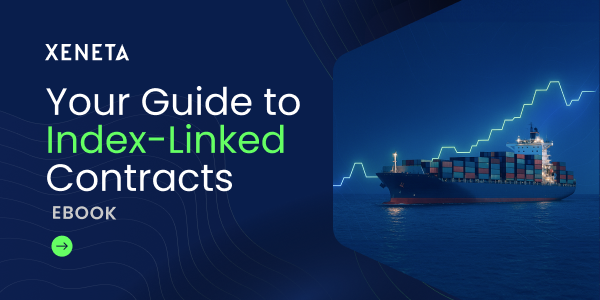In 2021, U.S. companies lost an average of $228 million each due to supply chain disruptions, with factory shutdowns being a major contributor (statista). That same year, in-shelf availability rates for items like fruits, vegetables, and beverages fell below 90% (NielsenIQ).
Faced with empty shelves, 20% of U.S. consumers delayed their purchase, 10% bought the item elsewhere, and 16% turned to online sources – resulting in retailers losing 46% of potential sales.
In short, when your shelves are empty and factories closed, you’re not making money.
We’ve entered an era of continuous market volatility, and the conditions we’re seeing today appear to be here to stay.
Market fluctuations are sharp, frequent, and aggressive. Freight rates can surge by thousands in a single day, upending procurement strategies and putting immense pressure on budgets. For freight procurement teams, one question stands above all others: how can we accurately forecast our freight spend when costs, conditions, and contracts are all changing so rapidly?
It’s time for everybody to get comfortable with reforecasting
The truth is, accurately forecasting freight spend in 2025 is a little like building a sandcastle at high tide – you plan for the tide but not for the puppy hurdling down the beach towards your masterpiece. Before you know it, your castle is back to sand and your plans are back to square one.
With shifting market dynamics, unpredictable disruptions, and fluctuating demand, even the best data models can struggle to provide reliable forecasts. This challenge grows when business decisions are made at the C-suite level without input from procurement teams, who understand the nuances of freight. The key isn’t trying to predict the future with absolute certainty, but rather building flexibility into your operations so you can respond quickly and strategically as conditions evolve.
As we’ve seen with recent US-imposed tariffs, the immediate reaction to such events typically falls into one of three categories: wait and see, frontload to maintain healthy stock levels (while exposing yourself to the spot market), or continue with minimum quantity commitments while absorbing additional costs (surcharges, tariffs, potential loss of sales, etc.).
Then, something interesting happens.
Once the dust settles into a familiar, albeit chaotic, rhythm, the industry adapts. People stop fixating solely on the ups and downs and instead, shift their focus toward building resilience into their decision-making models. This includes tracking market developments and modeling the likely impacts on supply chains, contracts, and supplier relationships.
The problem is, most shippers already have contracts in place before a Black Swan event hits. These long-term agreements, often set in motion months in advance, can leave shippers vulnerable to unforeseen disruptions and unfavorable terms, leaving little room to pivot when conditions change rapidly.
So, the question shouldn’t be “how can we better forecast for today’s volatility?” but rather, “how can we better position ourselves to reforecast quickly, accurately, and with confidence once a disruptive event emerges?”
The first step is ensuring that everyone in your organization understands disruption is now the expectation, and forecasting cycles need to become shorter. If you’ve got senior leaders holding you to the expectations set in forecasts 6+months ago, that’s a problem.
Another step you can take is to move away from rigid, long-term forecasts and toward a freight strategy that embraces agility. Consider onboarding tools that allow you to negotiate shorter contract terms more frequently and focus on forecasting for the months ahead, with flexibility built into your contracts – perhaps even exploring index-linked contracts with your freight forwarders.
The reality is that the landscape is likely to change significantly in the near future, and your contracts need to reflect that.
Looking back to look forward
What happens once disruption actually arrives?
The word unprecedented has been thrown around a lot since the COVID-19 pandemic. But very few of the unforeseen events that disrupt our supply chains today truly have no precedent. In quite a few cases, once a disruptive event happens, you can look back at historical data to see how very similar events impacted markets, and make informed forecasts and predictions from that.
For example, when President Trump was elected for the second time in 2024, there was an immediate impact on international trade and supply. This caused panic for many organizations. But, those who had access to deep and detailed data about how the same period was handled when he was elected for his first term were able to make valuable projections about the short-term impact on markets and their operations.
At a time when everything is changing, and it feels like you have very little to base critical freight procurement decisions on, that’s invaluable. But there’s only so far historical data can take you.
As a Xeneta customer said recently:
“There’s a reason we don’t drive looking through our rear-view mirror. We can likely drive for a bit, but we’ll eventually crash.”
The problem with traditional freight intelligence approaches
When freight procurement teams need to make decisions, they turn to data. Whether it's insights from a trusted supplier, a freight intelligence platform, or their own internal datasets, data helps eliminate blind spots and drive more informed choices.
While most organizations already have some kind of external freight intelligence solution in place to support procurement decision-making and bolster their own datasets, few were built with today’s pace of change in mind.
Depending on the solution you have, teams may be working with snapshots of market data that are weeks or months old to work with. Following a major disruptive event, that data loses its value almost immediately. You’re looking at a market state which no longer exists and doesn’t accurately reflect the newly disrupted landscape.
This invites avoidable risk into your supply chain.
According to a 2024 Deposco, Inc. study, 58% of supply chain leaders struggle with delivery timing and order accuracy during peak seasons, highlighting major challenges in forecasting and planning. Without access to real-time data, businesses are left to react to market shifts, which can lead to unexpected costs, overburdened teams, and missed business opportunities. Inaccurate or outdated forecasts also increase the risk of overstocking or running out of inventory, while delays and inefficiencies can negatively impact customer satisfaction and loyalty.
Real-time freight intelligence, based on actual contracts, helps teams understand how other organizations are responding to disruptions, giving them a clearer view of expected costs, carrier performance, and contract terms post-disruption. By leveraging this data, procurement teams can make informed decisions, quickly adapt to changes, and minimize the financial and operational impact of disruptions, ensuring seamless supply chain continuity and maintaining competitiveness.
The tools enabling and supporting rapid reforecasting
Real-time data is essential for effective, accurate, and rapid reforecasting in volatile markets. But, it’s just one of a growing arsenal of tools that can help procurement teams succeed and create value in today’s ever-shifting freight landscape.
Indexing supports a shift away from routine annual contract renegotiations, and helps teams start picking the right moments in the market to renegotiate. This helps create the kind of dynamic and responsive freight procurement culture needed to weather today’s volatility.
Scenario planning is another powerful capability, enabling teams to model how theoretical disruptive events could impact their shipping operations and supply chain. Using historical data, it helps teams start to understand the potential upstream and downstream impacts of a black swan event. Then, they can work backwards from those impacts to ensure that when disruption does strike, they take the right steps to minimize its operational and financial impact.
Real-time freight intelligence enables a true evolution in how you forecast
With volatility here to stay, it’s time to fundamentally evolve how you view and manage forecasts in freight procurement. Even the best long-term forecasts are likely to be rendered inaccurate by unforeseen black swan events. So, it’s time to build the capabilities you need to rapidly reforecast when things change, and prepare for disruption before it strikes.
With a clear understanding of the potential impacts of disruption, and the data you need to confidently make the right choices post-disruption, you can mitigate the impacts of risks like overpaying for freight space, having your freight rolled when spot prices surge, or your supply chain grinding to a complete halt.
Xeneta provides curated historical market and freight data, alongside real-time data based on real contracts up to 3-months into the future. Our unique data insights are supported and contextualized by expert analysts and a huge community of shippers and carriers, making it simple to translate insight into the right actions at the right time.
To learn more about the Xeneta platform and how it can help you transform your future forecasts and rise to the challenges of continuous market volatility, revisit our latest webinar on future-proofing freight procurement, or jump straight into a demo today.
%201.png)







